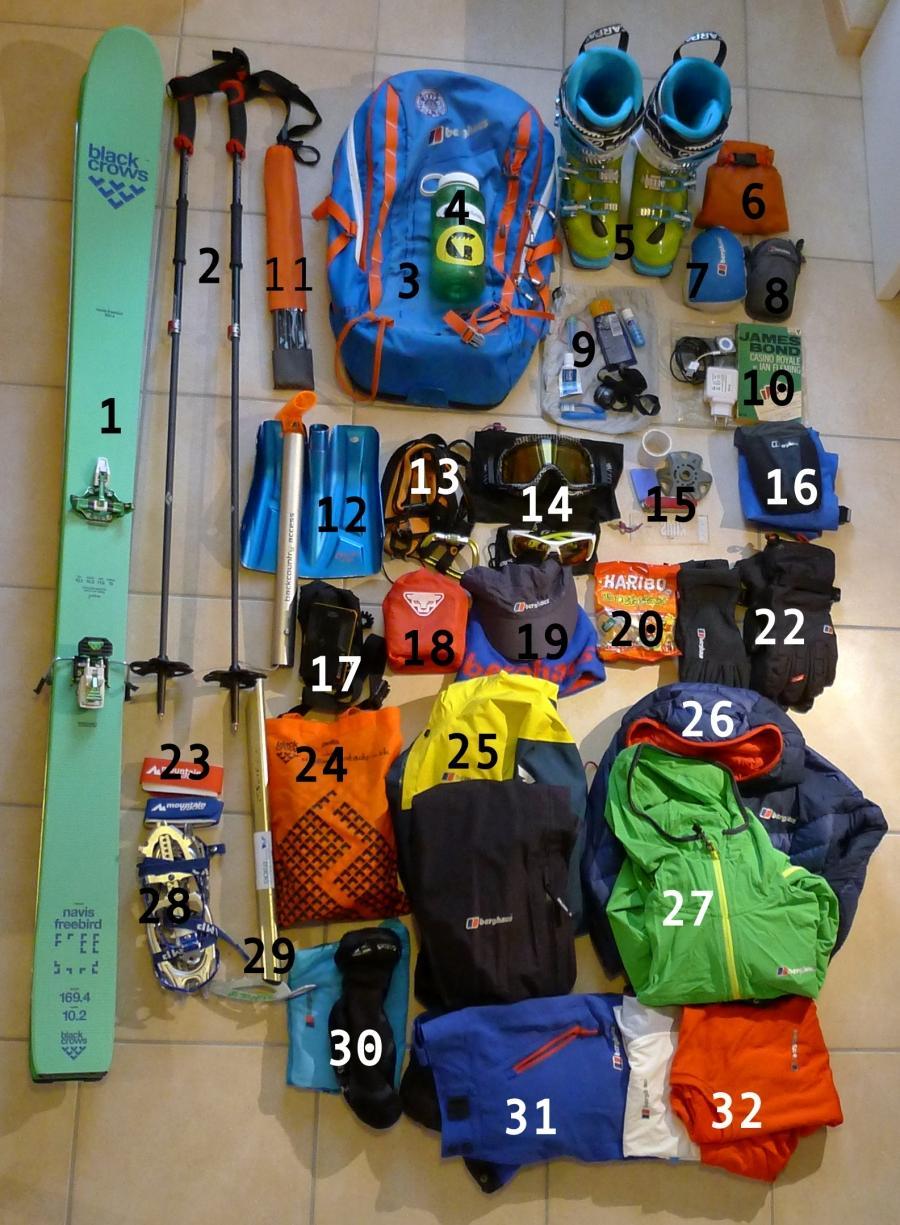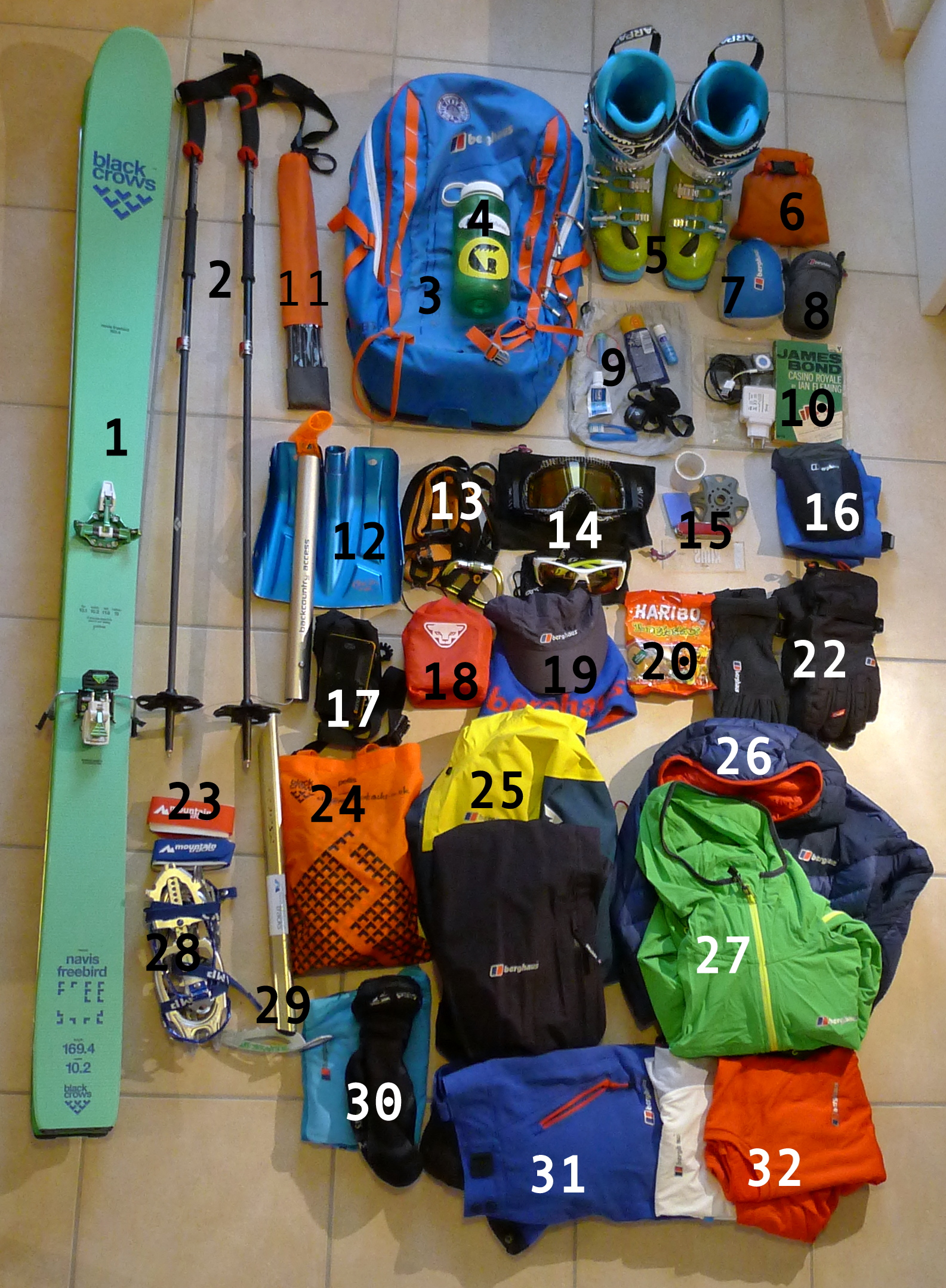
What’s in my ski touring Rucksack?
Winter Ski touring Equipment
The clothing and equipment you carry for winter backcountry skiing and ski touring is always a thorny subject with a vast array of kit on offer to baffle and confuse!
Remember the golden rule, ‘light is right’. Todays ski shops are awash with good quality, lightweight kit. The second rule is ‘be prepared for changing conditions’. During the ski touring season temperatures can be well below freezing in the mornings and reach double figures in the midday sun. Carry layers that allow you to adapt to the prevailing weather conditions.
Choose a good ski rucksack which concentrates all weight around the hip area. This prevents you overbalancing when turning downhill. Narrow tall climbing rucksacks aren’t ideal as they have a high centre of gravity. A secure way of attaching skis for carrying is also essential.
Your Mountain Guide will carry a rope, crevasse rescue equipment, map compass and other safety material. Your technical equipment should include a harness (with locking carabiner), ice axe, aluminium crampons (for advanced ski tours you'll need steel crampons), fitted skins, ski crampons, shovel, probe. We recommend a modern digital avalanche transceiver with new batteries.
Touring skis should be between 85mm and 100mm underfoot. Bindings can be either traditional 'Fritchi' or 'Dynafit' pin style. Ski Touring boots must have a walk mode and rubber sole. Poles ideally should be telescopic as I skin uphill with my poles at least 10cm longer than when skiing downhill. Don't forget large baskets on the end for pushing in soft snow.
Warm ski gloves can be supplemented with some thin, lightweight gloves for skinning with.
Pack a warm hat, sun hat and a pair of dark sunglasses. You must also carry ski googles with flat light lenses. Skiing in a white out without them is torture and dangerous.
Bring a water bottle (at least 1 litre and avoid 'Camelback' style systems as they freeze). Purchase a waterproof case for your money, passport, cards. A waterproof bag or stuff sack is essential to keep clothing dry in your rucksack.
For the huts, silk sleeping bag liner, ear plugs, toothbrush, wet wipes, suncream, lip block, book, ipod, and head torch. Some teabags and powdered milk is useful if you enjoy a proper cuppa! Snack food is a personal thing but I usually take some cereal bars, dried fruit, nuts, chocolate and jelly sweets.
Clothing wise a lightweight waterproof jacket and trousers are essential for bad weather. I use a soft shell jacket, fleece top, thermal long sleeve top. If the weather is cold I’ll have an extra thermal top and trousers. A lightweight duvet jacket or extra fleece is always at the bottom of my rucksack just in case. Soft shell trousers are great for ski touring and if a multi day tour I will carry an clean pair of socks and thermal. Check out the Berghaus ‘Extrem’ range, it's excellent technical kit that will cover most bases both winter and summer.
Remember when packing, heavy or spare stuff goes at the bottom and light, regularly used stuff at the top or in pockets.
There you have it! Hopefully this has shed some light on the mystical art of packing your rucksack! If you would like any more advice on technical equipment then use the search function on our website to access in depth articles.

1. Light touring skis and bindings
2. Extendable ski poles (large baskets)
3. Ski rucksack around 35 litres (must have a way to carry your skis)
4. Minimum 1 litre water bottle
5. Ski touring boots with walk mode and rubber sole
6. First aid kit including, blister plasters, pain killers, zinc oxide tape
7. Sheet sleeping bag for hut nights
8. Camera with spare battery
9. Hut kit, toothbrush & paste, sun cream, lip salve, ear plugs, small head torch
10. A waterproof container with music player, book, phone and charger
11. Avalanche probe at least 2.5m long
12. Metal shovel
13. Harness and 1 locking carabiner
14. Sung glasses and low visibility goggles
15. Spares kit with, pole basket, skin wax, plastic scraper, pen knife, duct tape
16. Dry bag for all kit and waterproof container with valuables, passport, money
17. Transceiver with fresh batteries (must be a modern digital type)
18. Ski Crampons (cuteau)
19. Warm hat and sun hat
20. Snack food
21. Thin gloves for skinning in
22. Thick ski gloves
23. Two ski ties for joining skis when on your rucksack
24. Ski skins (please check they fit your skis)
25. Lightweight waterproof jacket and trouser
26. Lightweight duvet jacket
27. Soft shell jacket
28. Aluminium crampons (on some advanced tours steel ones may be needed)
29. Aluminium ice axe (on some tours a steel head may be needed)
30. Spare socks and thermal for multi day tours
31. Soft shell trousers (add some thermal leggings if the forecast is cold)
32. Long sleeve thermal and fleece jumper
 Off-Piste
Off-Piste Ski Touring
Ski Touring Via Ferrata
Via Ferrata Ice Climbing
Ice Climbing Alpine Glacier Trekking
Alpine Glacier Trekking Worldwide Trekking
Worldwide Trekking





 Travel Website Development
Travel Website Development